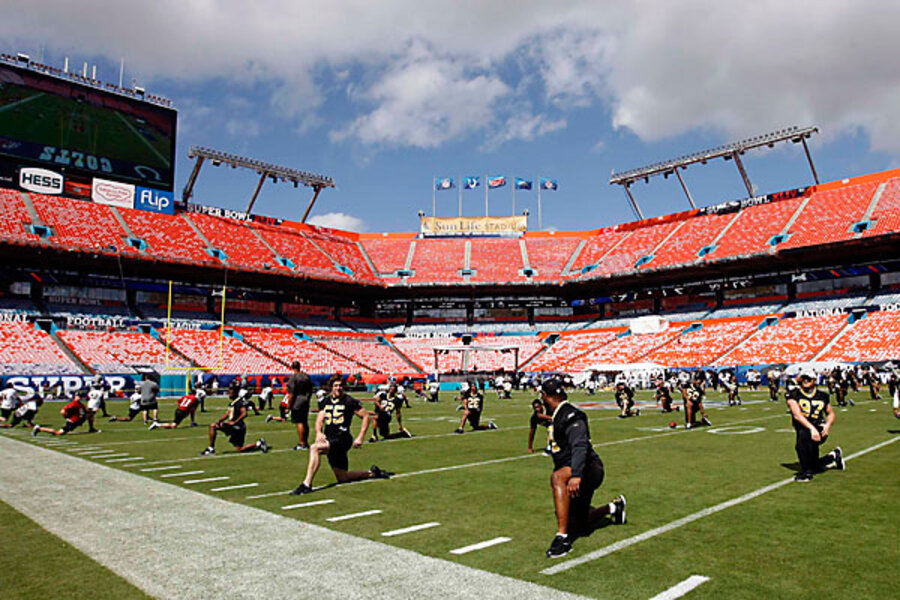Super Bowl 2010: when the best defense is a good offense
Loading...
| Miami
Very little has been left unsaid in the run up to Super Bowl XLIV Sunday night.
Yet during two weeks when the media cycle appears to resemble “lather, rinse, repeat,” one comment has been conspicuously absent: “Defense wins championships.”
That this most sacrosanct of sporting truisms should be missing on this of all weeks shows how radically the National Football League has changed during the past decade.
Defense could win the championship game tonight. But it is certainly not the primary reason that both teams are here. In terms of the baseline measure of yards allowed, the Indianapolis Colts and New Orleans Saints would rank 18th and 25th overall.
To compensate, each has developed an identity and a style of play that makes its defense better than the raw data might indicate. But Doomsday Defenses they are not.
The salary-cap era, which took hold last decade, has prevented teams from stockpiling limitless talent on both sides of the ball. At the same time, the NFL has also emphasized rules that encourage offensive play, protecting quarterbacks and freeing wide receivers from overly aggressive defenses.
It was the Colts who first demonstrated how dramatically these trends had changed the league, winning the Super Bowl in 2007 with a defense that was, by some measures, one of the worst in the history of football at stopping the run – allowing 5.3 yards per carry.
They were followed in 2008 by the New York Giants, who allowed 351 points in the regular season – the second most ever for a Super Bowl champion. Then in 2009, the Arizona Cardinals advanced to the title game despite allowing 426 points during the regular season – the most ever for a Super Bowl contestant.
Saints' flawed defense
This year, the Saints, in particular, are a defensive team beset by flaws.
Statistics by Football Outsiders suggest that the Saints’ two defensive tackles – Sedrick Ellis and Anthony Hargrove, the players charged with stuffing opposing running backs – are among the worst in the NFL at stopping the run. The result is that the Saints finished 26th of 32 NFL teams in terms of how many yards they allowed per carry.
The quality of the Saints’ defensive backs also declines notably after Jabari Greer, the team’s top cornerback. The Saints' worst run of the season coincided with an injury to Greer, notes Bill Barnwell of Football Outsiders.
Now that he has returned, teams have built their passing offenses around attacking the Saints’ other quarterback, Tracy Porter – a tactic that the Minnesota Vikings nearly rode to victory in the conference championship game two weeks ago.
The remedy for these shortcomings has been the mind of defensive coordinator Gregg Williams. Since he arrived in New Orleans last off-season, he has installed a new game plan for the Saints defense: bedlam.
Largely unable to sack opposing quarterbacks with his defensive linemen alone, Williams called for blitzes on 49 percent of Saints defensive plays during the regular season. And unable to prevent opposing offenses form gaining large chunks of yardage against his defense, Williams has instilled a different strategy of self-preservation: turnovers.
The Saints’ defense resembles nothing so much as a pack of wolverines, ripping and clawing at the football. Behind a defensive philosophy of “you can’t score if we take the ball away from you,” the Saints have turned a below-average defense into one that instills – if not fear, then at least a palpable sense of danger among opponents.
Colts' defense strategy
For their part, the Colts have merely refined the defense that was good enough for Super Bowl XLI.
The defense is essentially built on players that the rest of the NFL doesn’t want – players whose greatest attribute is their speed, not their size.
Ignored by other teams as too small to take the punishment of the NFL, they have evolved into one of the most relentless defenses in the NFL, coming in waves.
But for all their speed and intelligence, they are still undersized, and that has taken an annual toll in injuries. Football Outsiders consistently ranks the Colts among the league leaders in games lost to injury.
So it is this week with Dwight Freeney, the Colt defensive end whose injured ankle has been the subject of so much media speculation. He is just one of many battered Colts defenders.
Bob Sanders, the NFL Defensive Player of the Year in 2007, is out injured. So is starting cornerback Marlin Jackson. Another starting corner, Jerraud Powers, is questionable.
Indeed, it is key defensive injuries, more than any shortcomings of Peyton Manning, that have kept the Colts from competing for more Super Bowls. In a defensive scheme that leans heavily on defensive ends and middle linebackers, injuries to these two positions have derailed Colts seasons in the past.
Without Freeney in 2007 and middle linebacker Gary Brackett – essentially the quarterback of the defense – in 2008, the Colts lost in the first round of the playoffs.
With Freeney questionable for the Super Bowl, the Colts will hope history does not repeat itself.
---
Follow us on Twitter.





